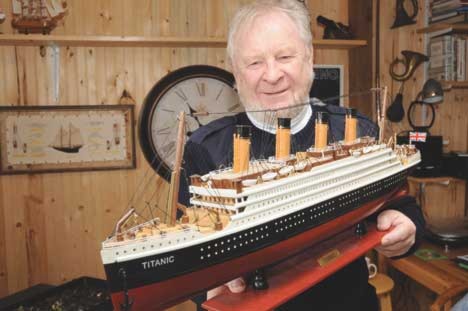April 15, 1912: Startling news arrived at noon that the new Titanic had collided with a iceberg on the Banks and was in danger. Over two thousand people on board...A Colonist bulletin says Titanic with 1,000 has gone down.
The entry is written in pencil, an extended footnote in a brief outline of Frank Grant’s day in the shipping department at Spencer’s department store in Victoria.
Grant, also an avid gardener, chronicled his life from the late 1890s to 1936, the year he died, in palm-sized daily diaries. His books have been passed down through the family over generations.
Grant’s great-grandson, Port Alberni resident David Hooper, is now the keeper of the family’s social history.
“He was part of the exodus from Nova Scotia with the failing of the shipping industry, the wooden sailing ships,” Hooper said of Grant.
April 16, 1912: I was up early and on the watch for the Colonist. The news about the Titanic is too true. She has disappeared with about 1,500 people. Rather a sorrowful day in town.
The demise of the RMS Titanic was a story that gripped the world. Owned by the White Star line, she was supposed to be unsinkable. She left Southampton, Hampshire, England on April 10, 1912 on her maiden voyage to New York.
Late in the evening on April 14, 1912, she struck an iceberg and sank in the Atlantic Ocean, some 600 kilometres south of Newfoundland.
For John Kenchenten, who owns a television production business in Port Alberni, the story of the Titanic is also the story of a lost branch of his family tree.
The Kenchentens grew generations of sailors, mostly in Southampton, where John’s great-uncle Frederick Kenchenten was an able seaman. The brother of John’s grandmother, Frederick joined the merchant navy as a “boy entrant”—likely at the age of 15.
In 1912 Frederick signed on as a greaser aboard the Titanic. Greasers worked in the turbine and reciprocating engine rooms carrying buckets of grease or oil, lubricating the mechanical equipment.
His position, Kenchenten surmises, was one of honour for a seaman.
“Not exactly press-ganged,” he said. “Remember, she was touted as quite a ship. It would have beaten working on a freighter.”
April 17, 1912: No better news from the Titanic. All the survivors are on the Carpathia and she is not due until tomorrow night.
Kenchenten’s great-uncle was not among those on the Carpathia. His body has never been found. He was 37 years old and died without marrying.
“Over the centuries we’ve lost many people to the sea,” Kenchenten said. He is the only son who did not enter the Royal Navy in England: he joined the army instead, although he does sail.
Grant would have been in his early 30s in 1912 when he heard the news about the Titanic’s sinking. A married father of young children.
April 18, 1912: No special news from the Carpathia. All the world waiting her arrival.
Grant’s diary entries are sprinkled with news about the weather, what his wife and children are up to and how busy he is in the mail order department. Through this social history, one can see how the history of Victoria played out a century ago. Life continued.
April 19, 1912: Full accounts in the morning paper about the Titanic disaster. About 1,600 lives lost; 650 saved on the Carpathia. Some very sad stories. Quite a gloom enshrouds every place.
Frederick Kenchenten was one of 885 crew members aboard the Titanic, including 33 greasers. Only four survived, according to a list of survivors and victims.
Five years ago, despairing because his grown children seemed indifferent to the family’s connection to Southampton, England and the Titanic’s story, Kenchenten decided to keep a history. He was familiar with the story, having taught at the University of Southampton for his first job.
Thirty years ago he visited one of the three cemeteries in Halifax, NS, where those bodies that were recovered from the Titanic disaster are buried.
There is no stone for his great-uncle Frederick.
“For that, you needed a body,” he said.
Kenchenten has a small shrine for the nautical side of his family in his River Road home, and he has even written a musical about the Titanic that he hopes one day will grace the stage at the Capitol Theatre.
April 21, 1912: Service at the Belmont church today...Memorial service in memory of the Titanic. Big crowd out.
All the way across the country from the disaster, Victorians mourned for the souls lost aboard the Titanic. One hundred years later, as England, Canada and the United States prepare memorials for the famed ocean liner, nothing has changed.
editor@albernivalleynews.com
